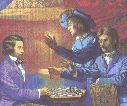
Goods
![]()
The chess site where beginners and ordinary club players learn to improve their chess
1 Openings Book Reviews
2 Instruction Books
3 Games Collections and Tournaments
New:
A Friend for Life?
Play 1.b3! The Nimzo-Larsen Attack: A Friend for Life (New in Chess) by Ilya Odessky
Book review by Stephen Berry
|
Chess Games Collections and Tournament Reviews.
by Tibor Károlyi (Batsford Chess 2004) £15.99 Buy from: www.amazon.co.uk T Parents and Sisters of Judit. The elder sisters of Judit (born 1976) are Zsuzsa (1969) and Zsofia (1974). Zsuzsa and Zsofia were strong players in their own right. Zsuzsa became women’s world champion and Zsofia attained an ELO rating of around 2500. Both Zsuzsa and Zsofia rarely play these days and neither have the ability of Judit to compete at the top level with the very best (above ELO 2700) males. The father Laszlo Polgar was the driving force behind the Polgar phenomenon. “Whenever I see the girls’ pictures in a chess magazine, I always feel Laszlo’s smaller photo should be on each picture as well. Almost all the ideas and initiatives came from him. He was the one who fought, and he made all the decisions.” The family used to live in a working class area of Budapest, in the district of Angyalfold. “They owned a shabby house – people in such houses had a modest standard of living. In those days teachers earned around 150 dollars a month …”. Károlyi maintains that the Polgar sisters grew up with chess as a second language. They were able to calculate variations much better than ordinary players. “ I think that this ability was the most important thing which Laszlo discovered. He also took a tremendous risk in experimenting with his own children. Would you take your children out of school just to prove you have discovered the best way to bring up a child who shows the potential to become an artist in a sophisticated form of puppetry?” Károlyi maintains that initially the Polgar parents were walking a financial tightrope. They could have fallen badly as they did not have enough money in the bank to provide financial security if their ideas went wrong. But Laszlo Polgar’ faith in his ideas was justified. The Polgar sisters became strong chess players and here lay the road to riches. It would have been unusual if only one of the Polgar sisters had become a strong player. But that all of them should ‘make it’ – this was remarkable and commanded the attention of not just the chess world. The Polgar sisters could command fees for chess tournaments and exhibitions which their male counterparts could only dream of. Trainer’s lament Book’s Shortcomings But one thing about this book (and other modern chess books) annoys me above all. The analysis of the games has become dominated by the computer. At some point in the game the annotator turns on the computer and produces extraordinarily deep and complex variations which even strong players will not have seen. As if by irritating contrast, some moves which obviously need comment are passed over. I will give a couple of examples. J. Polgar - Gutman
J. Polgar - K. Bischoff
The art of analysis for the average player, of which Alekhine and Botvinnik were conspicuous masters, seems to have disappeared. I would offer these guidelines: A) Important moments of the game should not be passed by. What may seem to be obvious tactics to a grandmaster should still be mentioned. Judit Polgar’s Combinative Brilliance Play through sample Games : MILOS v POLGAR | POLGAR v BERKES |

 his is one of the most interesting chess books that I have read in a long time. It is the story of rise of Judit Polgar, the best female chess player ever. But it is not only this. Károlyi, a strong Hungarian player and chess trainer, has a close knowledge of the Polgar clan. He has used it to provide a fascinating portrayal of the entire Polgar phenomenon.
his is one of the most interesting chess books that I have read in a long time. It is the story of rise of Judit Polgar, the best female chess player ever. But it is not only this. Károlyi, a strong Hungarian player and chess trainer, has a close knowledge of the Polgar clan. He has used it to provide a fascinating portrayal of the entire Polgar phenomenon. 




















